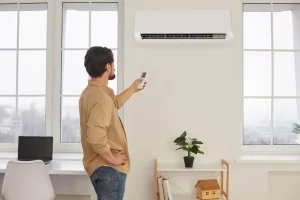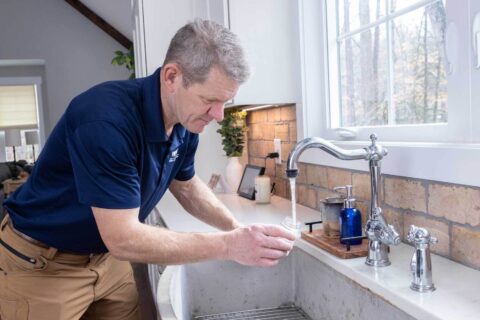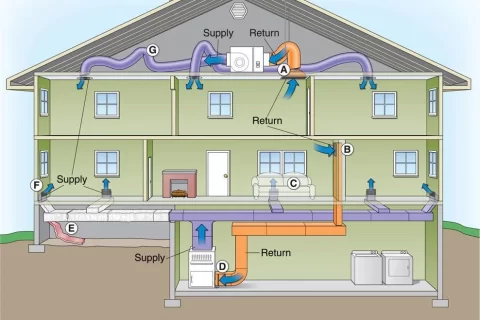Busting 7 Common Air Conditioning Myths
AC sizing myths debunked can save you time and money. Many believe bigger is always better when it comes to air conditioning units, but that myth has been busted during an ac tuneup visit, especially regarding the filter. This misconception can lead to poor performance and higher bills. Others think that all homes need the same size unit, ignoring unique factors like insulation and layout.
Understanding the truth behind AC sizing is crucial for comfort and efficiency. Choosing the right size unit ensures optimal cooling, lower energy costs, and a longer lifespan for your system. Get ready to uncover these common myths and learn how to make informed decisions for your home’s cooling needs.
Key Takeaways
-
Understand that bigger air conditioning units do not always mean better cooling; proper sizing is crucial for efficiency and comfort.
-
Be aware of thermostat myths; the location and type of thermostat can significantly affect your AC’s performance.
-
Consider using ceiling fans in conjunction with your AC to improve air circulation and reduce energy costs.
-
Regular maintenance of your AC system is essential for optimal performance and longevity; schedule routine check-ups.
-
Upgrading your AC system in a timely manner can lead to energy savings and improved comfort in your home.
-
Explore budget-friendly smart AC options that can enhance efficiency while managing costs effectively.
Common Misconceptions About AC Sizing
Misunderstanding Size Requirements
Many homeowners believe that bigger is better when it comes to air conditioning units. They think a larger unit will cool their space faster and more effectively. This myth can lead to purchasing an oversized central air conditioning unit. An oversized unit cools the room too quickly, leading to high humidity levels and discomfort.
Another common myth is that one size fits all. Homeowners often assume that the same air conditioning unit can work for different homes or spaces. Each home has unique factors like size, insulation, and sun exposure. These variables affect the required capacity for a central HVAC system.
Importance of Proper Sizing
Choosing the right size air conditioner unit is crucial for efficiency and comfort. An appropriately sized air conditioning unit provides even cooling throughout the space. It also runs efficiently, which reduces energy costs.
An undersized unit struggles to cool the area, leading to constant running and higher energy bills. The system may wear out faster due to overworking. This results in more frequent repairs and replacements. A properly sized central air conditioner balances comfort and cost-effectiveness.
Consequences of Misconceptions
Misconceptions about AC sizing can have significant financial impacts. Oversized units consume more electricity than necessary. This leads to increased energy costs over time. These units cycle on and off frequently, causing wear and tear.
An improperly sized central air conditioning system can also lead to inconsistent temperatures. Some areas may feel cold while others remain warm. Homeowners may end up relying on fans or other methods to achieve comfort.
Seeking Professional Advice
Consulting with a professional can help debunk these myths. Experts assess your home’s specific needs based on various factors. They consider square footage, ceiling height, and insulation quality. This assessment ensures you select the right air conditioner unit for your space.
Homeowners should also be aware of the importance of SEER ratings (Seasonal Energy Efficiency Ratio). Higher SEER ratings indicate better efficiency levels in current air conditioners. Choosing a unit with a higher rating can save money in the long run.
Bigger Is Not Always Better
Oversized Units
Many people believe that a larger air conditioning unit will cool their space better. This is a myth. Oversized units can cause frequent cycling. They turn on and off too often, leading to energy waste. This constant switching creates discomfort in your home. The system does not run long enough to remove humidity effectively.
When an AC unit runs for short periods, it fails to pull moisture from the air. This results in a sick environment with high humidity levels. High humidity makes the air feel warmer than it actually is. Homeowners may find themselves adjusting the thermostat lower, which wastes even more energy.
Moisture Removal Issues
Inadequate moisture removal leads to several problems. It creates an uncomfortable living space. A humid room feels sticky and can damage furniture or walls over time. Mold growth becomes a concern as well. Mold thrives in damp conditions, posing health risks to residents.
For instance, a family may notice mold spots appearing on their walls after installing an oversized system. They might think they need more cooling power, but the real issue lies in poor humidity control.
Proper Load Calculations
Calculating the right size for an AC unit is crucial. Proper load calculations take into account various factors like room size, insulation quality, and window types. These calculations help determine the perfect balance between comfort and efficiency.
Homeowners should consider using professional services for accurate assessments. Many rely on the “rule of thumb,” which can lead to mistakes. An incorrect size can result in wasted money and energy.
The right size also ensures that the system runs efficiently. It helps maintain consistent temperatures throughout the home. A well-sized unit operates smoothly without excessive strain.
Thermostat Myths and Realities
Temperature Settings
Many believe that lowering the thermostat temperature will cool a room faster. This is a widespread air conditioner myth. Air conditioning systems operate at a fixed speed. Lowering the temperature setting does not change how quickly the system cools the air. Instead, it simply makes the system work longer to reach that lower temperature.
When people set their thermostats too low, they often overwork their HVAC systems. This can lead to increased energy bills. The air conditioner runs continuously, trying to achieve an unrealistic temperature. It is important to understand that setting a thermostat to 70°F instead of 75°F does not mean quicker cooling.
Energy Efficiency
Incorrect thermostat settings can create issues with energy efficiency. Overworking the AC leads to more wear and tear on the unit. This can result in costly repairs or even the need for a replacement. A well-maintained HVAC system should run efficiently without excessive strain.
Setting your thermostat at a reasonable level promotes better cooling performance. The U.S. Department of Energy suggests keeping it around 78°F during the day when you’re home. This balance keeps you comfortable while also saving energy.
Smart Thermostats
Smart thermostats offer features that help manage cooling effectively. They learn your habits and adjust accordingly. For instance, they can raise the temperature when no one is home and lower it before you return. This reduces energy waste and maintains comfort.
Using a smart thermostat can also help identify signs of issues within your HVAC system. If your AC struggles to maintain the set temperature, it may indicate underlying problems. Regular maintenance checks can prevent these issues from escalating.
Vent Management
Another common air conditioning myth involves vent management. Some believe closing vents in unused rooms saves energy. However, this practice can disrupt airflow in the entire HVAC system. It creates pressure imbalances that may damage components over time.
Properly managing vents ensures efficient air circulation throughout your home. Keeping all vents open allows for balanced airflow, which supports effective cooling.

Placement of Your Thermostat Matters
Strategic Location
The location of your thermostat plays a crucial role in its effectiveness. Placing it in the right spot ensures accurate temperature readings. A thermostat needs to sense the average temperature of the room. If it is placed near a heat source, like a lamp or heater, it will give false readings.
Thermostats work best when they are centrally located. This helps them gauge the overall temperature accurately. Avoid placing them in corners or behind doors. These spots can trap heat and lead to incorrect settings.
Sunlight Exposure
Sunlight exposure significantly affects thermostat performance. Direct sunlight can cause the thermostat to read higher temperatures than actual. This results in the HVAC system working harder than necessary.
Consider this: if your thermostat gets afternoon sun, it might signal for cooling when it’s not needed. This leads to increased energy bills and unnecessary wear on your system. Use shades or curtains to block direct sunlight from hitting the thermostat.
Airflow Considerations
Airflow around the thermostat also matters. Blocked airflow can lead to inaccurate temperature readings. Ensure that furniture or other objects do not obstruct the thermostat.
A clear path allows air to circulate freely. This helps the thermostat respond correctly to changes in temperature. Remember, thermostats need consistent airflow to function properly.
Avoiding Problematic Locations
e locations can skew temperature readings and impact system performance. For example, avoid placing thermostats near exterior walls. These walls may be colder or hotter than the interior space.
Also, keep thermostats away from drafts. Doors and windows can create drafts that affect readings. Similarly, avoid placing them near appliances that generate heat, like ovens or refrigerators.
Best Practices for Placement
To ensure optimal performance, follow these guidelines:
-
Place thermostats in central areas.
-
Keep them away from direct sunlight.
-
Avoid walls with extreme temperatures.
-
Ensure good airflow around the device.
-
Regularly check for obstructions.
The Role of Ceiling Fans
Comfort Enhancement
Ceiling fans do not actually lower the room temperature. They create a wind-chill effect that makes you feel cooler. This happens because the moving air evaporates moisture from your skin. As a result, you may feel more comfortable at higher temperatures.
Many people rely solely on air conditioning for cooling. However, combining ceiling fans with air conditioners can improve comfort levels significantly. The movement of air helps distribute the cold air produced by the air conditioner more evenly throughout the room. This means you can set your thermostat to a higher degree and still feel cool.
Seasonal Adjustments
Adjusting the direction of your ceiling fan is crucial for maximizing its effectiveness. During warmer months, fans should rotate counterclockwise. This pushes cool air down, enhancing the cooling effect in the room. In contrast, during colder months, switch the fan to rotate clockwise. This pulls cooler air up and forces warm air down along the walls.
These simple adjustments can lead to better heating and cooling efficiency. Many homeowners overlook this important step. As a result, they miss out on potential energy savings.
Air Circulation
Using ceiling fans improves overall air circulation in a room. Stagnant air can make a space feel uncomfortable, even when using an air conditioner. Ceiling fans help move air around, preventing hot or cold spots in your home.
Proper air circulation also supports the effectiveness of air filters in your cooling system. Dust and allergens can accumulate if airflow is blocked or stagnant. A ceiling fan helps maintain consistent airflow, allowing your air conditioning unit to work better.
Energy Efficiency
Ceiling fans are energy-efficient devices. They consume less electricity compared to traditional air conditioning units. Running a ceiling fan while using an AC unit can reduce energy costs significantly.
This practice allows you to enjoy cooler temperatures without overworking your big air conditioner. You might even find that you can raise your thermostat setting by a few degrees without sacrificing comfort.
Importance of Regular Maintenance
Routine Maintenance
Routine maintenance is essential for any air conditioning unit. It helps ensure efficient AC operation and extends the lifespan of the system. Without it, units can face issues that lead to costly repairs. Many homeowners overlook this crucial aspect, thinking their system will run fine without help. However, neglecting maintenance often results in frequent cycling and reduced efficiency.
Regular HVAC maintenance includes checking filters, coils, and other critical components. Dirty filters can restrict airflow and force the unit to work harder. This increases energy consumption and leads to higher bills. Regularly changing or cleaning these filters is a simple task that makes a big difference.
Common Tasks
Several common maintenance tasks can prevent problems before they start. Cleaning the condenser coils is one such task. Dust and debris can build up on these coils, causing the unit to lose efficiency. A clean coil allows for better heat exchange, keeping your home cooler with less energy.
Checking the thermostat settings is another important step. Ensuring that the thermostat functions correctly helps maintain consistent temperatures in your house. A malfunctioning thermostat can cause the unit to run longer than necessary, leading to wear and tear.
Inspecting ductwork for leaks can improve performance. Leaks allow cool air to escape, making the system work harder to cool your home. Sealing these leaks can enhance energy efficiency and comfort.
Professional Inspections
Scheduling professional inspections is vital for keeping your AC running smoothly. Technicians have the expertise to identify issues that may go unnoticed during routine checks. They can perform spring air conditioning checkups to ensure everything operates correctly before summer heat arrives.
During these inspections, professionals check all components of the unit. They look for signs of wear and tear that may require repair. Addressing these issues early prevents them from becoming more significant problems later.
Homeowners should aim for at least one professional inspection per year. This proactive approach can save money in the long run by avoiding unexpected breakdowns.
Benefits of Timely AC Upgrades
Energy Savings
Upgrading to a new air conditioner can lead to significant energy savings. Older units often consume more electricity than necessary. Newer models are designed with better technology, allowing them to cool more efficiently.
The U.S. Department of Energy states that replacing an old unit with an efficient air conditioner can reduce energy bills by 20% to 50%. This means homeowners save money while staying comfortable.
Advanced Technology
Recent advancements in air conditioning technology enhance cooling efficiency. Modern units use variable-speed compressors. These compressors adjust their speed based on the cooling demand. This feature allows for more consistent temperatures and lower energy usage.
Many new air conditioner units also come with smart technology. Homeowners can control their systems remotely through smartphones. This convenience helps manage energy consumption even when they are away from home.
Environmental Impact
New air conditioning systems have a smaller environmental footprint. They use refrigerants that are less harmful to the ozone layer compared to older models. Many manufacturers focus on producing eco-friendly options.
By choosing efficient air conditioners, homeowners contribute to a healthier environment. Reduced energy consumption leads to lower greenhouse gas emissions. This change benefits not just individual homes but the planet as a whole.
Avoiding Emergency Replacements
Homeowners should consider upgrades before their current unit fails. Waiting until an AC breaks down can lead to emergency replacements. These situations often result in higher costs and limited options for repairs.
Scheduling an AC tune-up visit can reveal potential issues before they escalate. Technicians can identify worn parts or inefficiencies during regular maintenance checks. Addressing these problems early can extend the life of the system.
Comfort Levels
Upgrading to a new air conditioner improves overall air conditioning comfort in the home. New models provide better humidity control and airflow distribution. Homeowners enjoy cooler and more consistent indoor temperatures.
Older units may struggle to maintain comfort levels, especially during peak summer months. A new system ensures a pleasant living environment throughout the year.
Smart AC on a Budget
Cost-Effective Options
Smart air conditioners come with smart features that enhance energy management. Many models allow you to control the temperature from your phone or tablet. This feature can help you monitor usage and adjust settings based on your schedule.
Thermostats like the Nest Learning Thermostat offer great savings. It learns your habits over time, adjusting the temperature when you’re home or away. These options can significantly reduce your energy bills.
Optimize AC Use
Simple strategies can optimize your AC use without high costs. Regularly changing or cleaning the filter is essential. A clean filter improves airflow and efficiency, leading to lower energy consumption.
Setting the thermostat a few degrees higher during peak hours can also save money. Even a small adjustment can lead to noticeable savings over time. Using fans in conjunction with your AC can help circulate air more efficiently.
Monitor Cooling Needs
Using smart technology helps monitor and adjust cooling needs effectively. Smart air conditioners can track usage patterns and suggest optimal settings. This process allows homeowners to balance comfort and energy costs.
For example, during spring, you might not need full cooling power. Adjusting settings based on the season can lead to significant savings. Some systems even provide reports on energy usage, helping users understand their consumption better.
Potential Savings
The potential savings from using smart technology are substantial. Studies show that homes equipped with smart thermostats can save up to 15% on cooling costs annually. This figure translates into real savings over time, especially during hot summer months.
Investing in smart air conditioners may seem costly upfront, but the long-term benefits outweigh these initial expenses. The ability to control your system remotely means you only use energy when needed.
Shop Wisely
When shopping for an air conditioner, consider capacity as well. An oversized unit will cool too quickly, leaving humidity behind. An undersized unit will struggle to keep up, leading to higher energy bills.
Understanding your space’s needs is crucial before making a purchase. Look for units that fit within your budget while providing necessary features. Researching different brands and models ensures you find the best option for your home.
Closing Thoughts
Understanding AC sizing myths is crucial for your comfort and energy efficiency. You’ve learned that bigger isn’t always better and that proper thermostat placement can make a world of difference. Regular maintenance and timely upgrades keep your system running smoothly, while ceiling fans can enhance airflow without breaking the bank.
Don’t let misinformation steer you wrong. Use this knowledge to make informed decisions about your cooling needs. Evaluate your current setup and consider adjustments where necessary. Your comfort and savings depend on it. Take action today to optimize your AC system for a cooler tomorrow!
Frequently Asked Questions
What is the biggest myth about AC sizing?
The biggest myth is that bigger units cool better. Oversized AC systems can lead to inefficient cooling and increased humidity, resulting in discomfort.
How does thermostat placement affect AC performance?
Thermostat placement is crucial. If placed in direct sunlight or near heat sources, it may misread temperatures, causing inefficient cooling.
Can ceiling fans help my air conditioning?
Yes, ceiling fans can enhance airflow and make your space feel cooler. They allow you to set your thermostat higher without sacrificing comfort.
Why is regular maintenance important for my AC unit?
Regular maintenance ensures your AC runs efficiently, prolongs its lifespan, and prevents costly repairs. It also improves indoor air quality.
When should I consider upgrading my AC system?
Consider upgrading if your unit is over 10 years old, requires frequent repairs, or isn’t cooling effectively. Timely upgrades save energy and costs.
Are smart thermostats worth the investment?
Absolutely! Smart thermostats optimize energy use by learning your habits and adjusting temperatures accordingly, leading to significant savings on utility bills.
How can I size my AC correctly?
To size your AC correctly, consult a professional who will assess factors like room size, insulation, and climate conditions for optimal performance.


